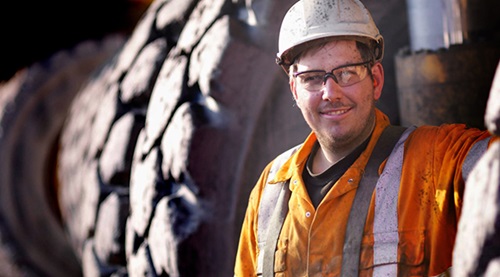Latest news
Article
How investment markets impact your super returns
By Seamus Collins, Chief Investment Officer
Rising inflation, higher interest rates, China’s slowdown and war in Ukraine have hit economic growth and investment returns this financial year. This means most super funds will deliver much lower returns than the remarkably high returns we saw
last financial year. It’s a shared experience across the super industry and bears reminding of the importance of staying the course when it comes to super. To help you understand where we’ve been and where we are, we look at the remarkable
events in 2021 and 2022 that are having dramatically different impacts on investment markets.
Looking back to FY2020-21: A remarkable year for returns
The 2020-21 financial year was one of the strongest on record for super funds. Our super High Growth option returned 26.20%, while the Conservative Balanced option grew 13.57% as share markets recovered strongly from the COVID-19 crash in early 2020.
This was an exceptional period in which returns were far from normal. This left many members’ super balances in great shape, even those who are many years from retirement.
| According to research agency Chant West, in the 2020-21 financial year, super funds delivered their strongest financial year results in 24 years. The median growth fund returned a stunning 18%, which is the second highest return since
the introduction of compulsory superannuation in 1992. Source: Chant West, Super Funds Post a Stunning 18% Gain – The Second Highest Return Ever, 19 July 2021 |
Followed by more challenging markets this financial year
The 2021-22 financial year has been rather more challenging for investors. Recently, we’ve seen inflation rise steeply – which often happens when interest rates have been kept low for a while. Central banks have also started to increase interest rates back towards more normal levels.
In June, the Reserve Bank of Australia (RBA) hiked the cash rate for a second time, to 0.85%, and a series of further rises are expected over the next 12 months. This is slowing the housing market, which impacts banks and broader consumer spending across the economy.
Rising interest rates lead to higher bond yields, i.e. lower bond prices. Shares and property also become less attractive as interest rates rise and the risk of recession increases. Share prices have grown more volatile over this financial year, especially during recent months.
China’s COVID-19 lockdowns have closed factories, interrupting exports of goods and components in the global supply chain. These shortages of goods have raised prices further.
War in Ukraine has led to western sanctions and rising demand for non-Russian energy supplies and agricultural commodities such as wheat. Higher energy and food prices add further to inflation and reduce disposable incomes, slowing consumer spending.
What this means for your super
This has meant investment returns have been more volatile this financial year and much lower than last year’s exceptional performance. In the 11 months to 31 May 2022, our super High Growth option delivered a -0.79% return, while the Conservative Balanced option returned -0.62%.
It’s important to think long-term about your super
Seeing the value of your super go down is never easy. However, super is a long-term investment and share markets generally recover over the longer term. So, although one-year returns can fluctuate a lot, generally, longer-term returns will be steadier.
For example, while the High Growth option one-year return dropped from 26.20% pa at 30 June 2021 to 1.91% pa at 31 May 2022, the 10-year return of this option only dropped from 9.33% pa to 9.27% pa over this time period. Likewise, the Conservative Balanced option one-year return dropped from 13.57% pa at 30 June 2021 to 0.72% pa at 31 May 2022, with the 10-year return only dropping from 6.53% pa to 6.15% pa over the same period.
| Did you know? If you start contributing to super at age 25 and retire at age 67, your investment timeframe is more than 40 years. And if you keep your super until after you retire, it could easily add another 15 years or more. |
Investing your super in a diversified option brings the benefit of exposure to a wide range of asset classes, so you’re not putting all your eggs in one basket. Returns from international shares, bonds and cash have generally been weak this financial year. However, unlisted property and infrastructure assets benefitted from relatively secure income, while Australian shares have gained from strong commodity prices. Nonetheless, overall returns for diversified options are expected to be relatively low over the 2021-22 financial year to 30 June 2022.
For an overview of the historical investment performance for the option/s that you’re invested in, head to the Investment performance page.
Investment returns for a typical member
The below table outlines how the balances have changed for a 40 year old and 67 year old member invested in the super Lifecycle Investment Strategy. It does not take into consideration any contributions, fixed administration fees or insurance premiums.
 |
 |
|
A 40 year old member; 100% invested in the super Lifecycle Investment Strategy (High Growth):
|
A 67 year old member; 100% in the super Lifecycle Investment Strategy (Conservative Balanced):
|
NOTE: the above examples do not take into consideration any taxes or fees paid, or contributions received during this period. These investment options were renamed High Growth (previously Aggressive) and Conservative Balanced (previously Balanced) on 25 March 2021. Investment returns outlined in the table above cover periods when these investment options were also operating under their previous names.
Did you know? 83% of our super members are invested in the Lifecyle Investment Strategy (PDF), which is made up of a mix of the High Growth and / or Conservative Balanced options, based on your age.
Looking ahead
Global uncertainty means that predicting short-term movements in asset prices is almost impossible. It’s more appropriate to view super as a long-term investment that needs time to grow and benefit from the effect of compounded earnings growth.
Attempting to time the market – especially when markets have fallen
– can impact the chances of meeting your long-term goals.
Turn to Mine
It’s a good idea to review your super from time to time to see if you’re still happy with the investment options in which you’re invested. If you’re a member, you can call us for an account health check, including advice from Mine Super Financial Advice about how your account is invested, at no extra cost. For more complex advice, you can request an appointment online. And did you know? Members are entitled to a complimentary initial appointment.
Past investment performance isn’t necessarily an indication of future performance.